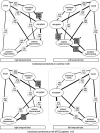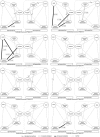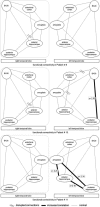Decreased basal fMRI functional connectivity in epileptogenic networks and contralateral compensatory mechanisms
- PMID: 18661506
- PMCID: PMC6870867
- DOI: 10.1002/hbm.20625
Decreased basal fMRI functional connectivity in epileptogenic networks and contralateral compensatory mechanisms
Abstract
A better understanding of interstructure relationship sustaining drug-resistant epileptogenic networks is crucial for surgical perspective and to better understand the consequences of epileptic processes on cognitive functions. We used resting-state fMRI to study basal functional connectivity within temporal lobes in medial temporal lobe epilepsy (MTLE) during interictal period. Two hundred consecutive single-shot GE-EPI acquisitions were acquired in 37 right-handed subjects (26 controls, eight patients presenting with left and three patients with right MTLE). For each hemisphere, normalized correlation coefficients were computed between pairs of time-course signals extracted from five regions involved in MTLE epileptogenic networks (Brodmann area 38, amygdala, entorhinal cortex (EC), anterior hippocampus (AntHip), and posterior hippocampus (PostHip)). In controls, an asymmetry was present with a global higher connectivity in the left temporal lobe. Relative to controls, the left MTLE group showed disruption of the left EC-AntHip link, and a trend of decreased connectivity of the left AntHip-PostHip link. In contrast, a trend of increased connectivity of the right AntHip-PostHip link was observed and was positively correlated to memory performance. At the individual level, seven out of the eight left MTLE patients showed decreased or disrupted functional connectivity. In this group, four patients with left TLE showed increased basal functional connectivity restricted to the right temporal lobe spared by seizures onset. A reverse pattern was observed at the individual level for patients with right TLE. This is the first demonstration of decreased basal functional connectivity within epileptogenic networks with concomitant contralateral increased connectivity possibly reflecting compensatory mechanisms.
(c) 2008 Wiley-Liss, Inc.
Figures







References
-
- Addis DR,Moscovitch M,McAndrews MP ( 2007): Consequences of hippocampal damage across the autobiographical memory network in left temporal lobe epilepsy. Brain 130(Pt 9): 2327–2342. - PubMed
-
- Baas D,Aleman A,Kahn RS ( 2004): Lateralization of amygdala activation: A systematic review of functional neuroimaging studies. Brain Res Brain Res Rev 45: 96–103. - PubMed
-
- Bartolomei F,Wendling F,Bellanger JJ,Regis J,Chauvel P ( 2001): Neural networks involving the medial temporal structures in temporal lobe epilepsy. Clin Neurophysiol 112: 1746–1760. - PubMed
-
- Bartolomei F,Wendling F,Regis J,Gavaret M,Guye M,Chauvel P ( 2004): Preictal synchronicity in limbic networks of mesial temporal lobe epilepsy. Epilepsy Res 61: 89–104. - PubMed
Publication types
MeSH terms
Substances
LinkOut - more resources
Full Text Sources
Medical

